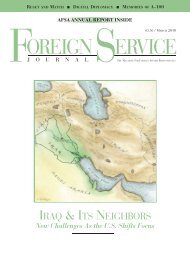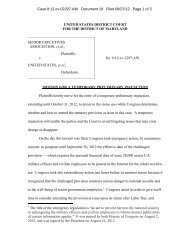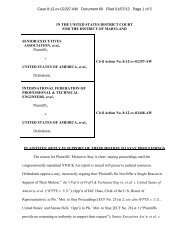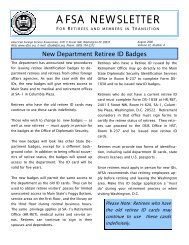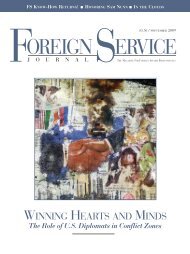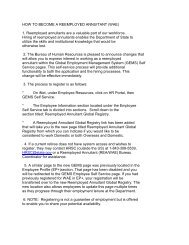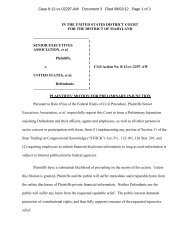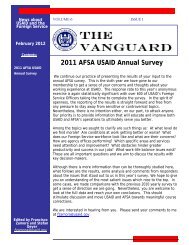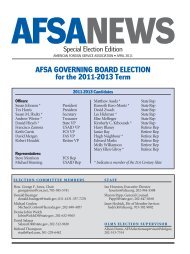F OCUS - American Foreign Service Association
F OCUS - American Foreign Service Association
F OCUS - American Foreign Service Association
You also want an ePaper? Increase the reach of your titles
YUMPU automatically turns print PDFs into web optimized ePapers that Google loves.
tary and diplomatic representatives from Afghanistan,<br />
Pakistan and coalition forces in Afghanistan — have contributed<br />
effectively to soothing the tensions. They do not,<br />
however, suppress the fundamental security dilemma<br />
Pakistan faces in its relations with its weaker neighbor.<br />
At the same time, it would be a mistake to treat<br />
Pakistan’s current support to the Taliban as a simple replay<br />
of the 1990s. Although its objectives are evolving along<br />
with the Afghan situation itself, Islamabad is no longer trying<br />
to take control of its neighbor through its Afghan<br />
proxy. Rather, it is trying at once to pressure the current<br />
government in Kabul, ensure a robust <strong>American</strong> and<br />
international presence, and prepare for a post-U.S.<br />
Afghanistan. In such a context, the Taliban remains a useful<br />
instrument that Islamabad can manipulate at will and<br />
is unlikely to give up.<br />
The Pakistani Taliban<br />
A new phenomenon, the emergence of a Taliban<br />
movement in the Federally Administered Tribal Areas of<br />
Pakistan, raises a series of new questions. It is not clear<br />
whether the movement is sui generis or the result of<br />
Pakistan’s own involvement in Afghan affairs. Many<br />
observers describe the Pakistani movement as a simple<br />
extension of its Afghan counterpart and see its emergence<br />
in Pakistan as evidence of a fundamentalist push in the<br />
region that threatens an already fragile Pakistani polity<br />
and, with it, the stability of the entire region.<br />
The Pakistani Taliban arose in a gradual process made<br />
possible by the oscillation between military operations<br />
and “peace agreements” in the area from 2004 to 2006.<br />
The former provided the Taliban and their al-Qaida allies<br />
with local support that would have been more difficult to<br />
mobilize otherwise; the latter gave them the opportunity<br />
to reorganize and extend their networks.<br />
One group, the Tehrik-i-Taliban Pakistan, deserves<br />
particular attention, not merely because it was held<br />
responsible by the Pakistani government for the December<br />
2007 assassination of former Prime Minister Benazir<br />
Bhutto (although its leader, Baitullah Mehsud, denied any<br />
responsibility). More importantly, this organization now<br />
seems to control the entire Taliban movement in Pakistan.<br />
The TTP’s main objectives are to enforce Sharia (Islamic<br />
law), unite against NATO forces in Afghanistan and perform<br />
defensive jihad against the Pakistan army.<br />
Although its name was not new, the group surfaced in<br />
its present form last December. Essentially an umbrella<br />
F <strong>OCUS</strong><br />
organization, it has regrouped existing local militant formations<br />
covering a vast geographic area, including all of<br />
the FATA’s seven tribal agencies and a number of districts<br />
in the settled areas of the NWFP. Today the TTP is said<br />
to have some 5,000 combatants, although it remains difficult<br />
to assess its real strength. Local youth sometimes join<br />
the militants as a way of earning a living or enhancing their<br />
social importance and power, according to reports by the<br />
International Crisis Group.<br />
Current estimates of the insurgents’ strength are<br />
sharply higher than those of a year earlier. In December<br />
2006, the ICG estimated the total number of militants in<br />
the FATA at about 1,100: 100 hardened foreign fanatics<br />
and 1,000 local accomplices. There were 25 to 35 local<br />
militant groups in North and South Waziristan. The phenomenon<br />
clearly took a new turn in 2007, with the networking<br />
of the many small militant groups operating in<br />
the FATA, who were, in turn, soon joined by many other<br />
extremist groups banned in Pakistan.<br />
Because the October 2005 Pakistan earthquake<br />
exposed their training camps, militants belonging to organizations<br />
of national importance such as the Jaish-e-<br />
Mohammad or the Lashkar-e-Toiba, heavily trained in<br />
guerilla operations by the Pakistani military for operations<br />
in Kashmir, also found their way to the FATA. Displaced<br />
by the ISI and relocated to the FATA and NWFP, where<br />
they were supposed to be less visible, they escaped the<br />
control of their sponsors and soon found themselves fighting<br />
the Pakistani military.<br />
One Taliban, or Two?<br />
The TTP’s link with the organization of Taliban<br />
Supreme Leader Mullah Omar in Afghanistan is unclear.<br />
The decrease in the number of attacks against NATO<br />
forces in Afghanistan since 2007 is sometimes attributed<br />
to the TTP engagement in Pakistan, as if the guerrillas on<br />
the two sides of the border were one movement. But this<br />
does not constitute evidence of any unity of command.<br />
The organizations that comprise the TTP certainly<br />
support and are inspired by the Afghan Taliban. Former<br />
commanders such as the late Nek Mohammad and<br />
Abdullah Mehsud participated in the jihad against the<br />
Soviets, and later resisted the Northern Alliance. Yet<br />
organizational links were always thin and remain limited<br />
today. This is not to dispute the claim, articulated by<br />
Harvard’s Hassan Abbas in the January CTC Sentinel, the<br />
online monthly of West Point’s Combating Terrorism<br />
JULY-AUGUST 2008/FOREIGN SERVICE JOURNAL 43



